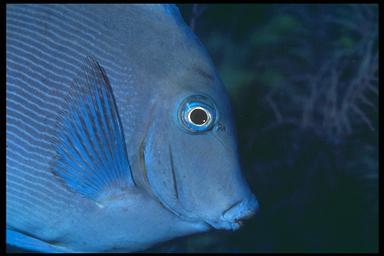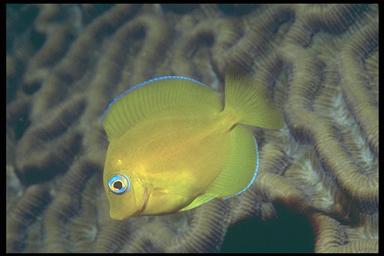Atlantic Blue Tang (Acanthurus coeruleus)

Blue Tang - Adult
The Atlantic blue tang (Acanthurus coeruleus) belongs to the family Acanthuridae, which includes the surgeonfishes and the other tangs. It is sometimes called the Carribean blue tang or simply the blue tang. They are found in the Caribbean and the West Atlantic ocean.
The Regal Tang or Pacific Blue Tang is also commonly known simply as "blue tang" and so to avoid confusion it is best to refer to Acanthurus coeruleus by its scientific name or as "Altantic blue tang."
In their natural habitat they are found along coral reefs where they feed on algae and occasionally on small crustaceans. Juvenile Atlantic blue tangs often eat the parasites off of marine turtles.

Juvenile Blue Tang
When Atlantic blue tangs are young they are mostly yellow in color as seen in the photo of the juvenile fish. The dorsal and anal fins and the eyes are outlined in blue. As the fish ages, the yellow color is replaced by the blue color seen in the photo of the adult. The adult also has horizontal lines on its body. Typically the caudal fin is the last part of the fish to lose its yellow coloration. They reach an adult size of about 9 inches (23 cm).
Atlantic blue tangs are herbivores and must be provided with a diet of marine algae and plant-based marine fish food in order for them to survive and remain healthy in captivity. They will eat thawed frozen food for marine fish and you can supplement their diet with seaweed (sushi nori). They will also eat meaty marine foods, but most of their diet should be plant-based.
It is best to keep a single blue tang in your tank because they often fight with members of their own species. They may be successfully kept in a reef tank.
Atlantic blue tangs can usually be obtained for about $25-75 dollars each. Juveniles are typically less expensive than adults.
